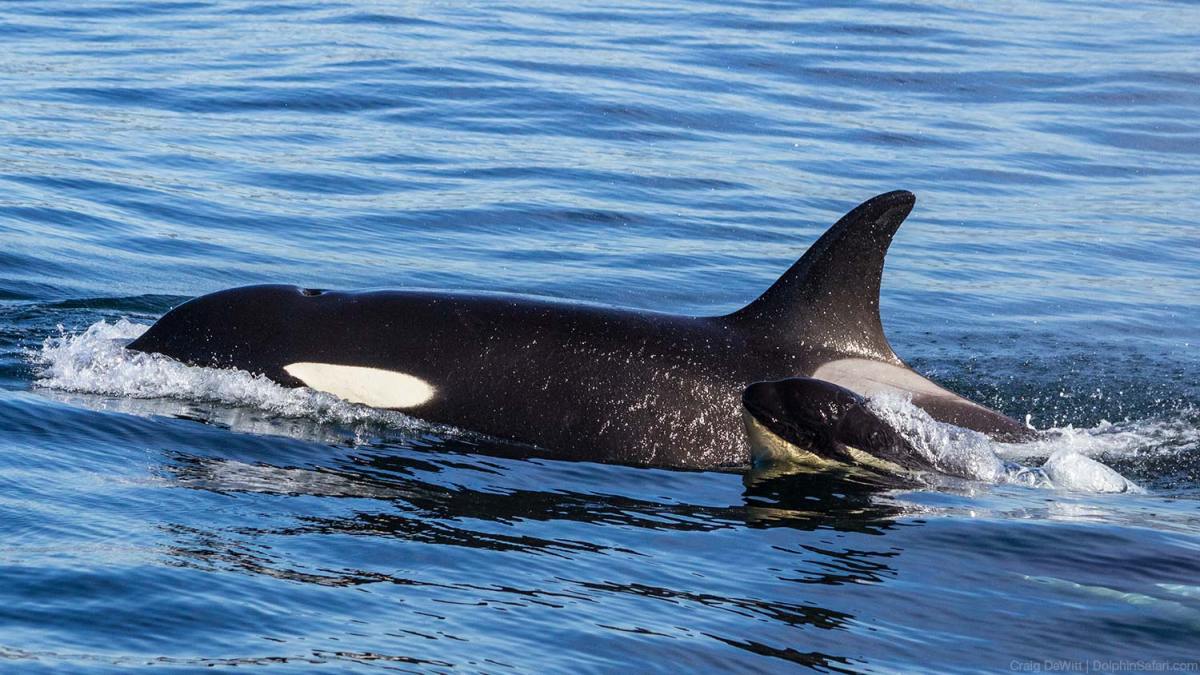Killer Whale Fast Facts
Scientific name: Orcinus Orca
Class: Mammalia
Average length: Up to 32 feet
Average weight: Up to 11 tons
Average lifespan: 30 to 90 years
Current population: 50,000
Cruising speed: 30 miles per hour
Gestation period: 15 to 18 months
Favorite snack: Depends who you’re asking! “Bigg’s” boys prefer peanut butter and seal sandwiches with Dolphin Doritos, while Offshore orcas crave a tangy salmon tartare.
Favorite tunes: Jazz beats
Favorite pastime: Scrabble and water coloring

Orca (Killer Whale)
Killer Whales: Dive Deeper
Craving a spine-tingling adventure? Hoping to spot a Free Willy look-alike, while you allow your inner arrr matey captain self to buoy up with excitement, and kick a tippy-topper off of your bucket list? Maybe you’ve contemplated sporting a day at SeaWorld to catch a killer glimpse of a famous killer whale?
Whale look no further! Here at Captain Dave’s we spot these beautiful black and white mammals in their very own natural habitat, minus the popcorn speckled floors, in mother nature’s own sea world.
Yep! Killer whales. This name may remind you of your favorite childhood stuffed animal, or spark feelings of fear, excitement, and suspense all in one seafood enchilada, but did you know that killer whales are in fact, not whales?
Read on to learn more about these fascinating non-whale whales.
What Do Killer Whales Look Like?
Killer whales, also known as Orca, are actually members of the dolphin family, and have the distinction of being the largest dolphin in the world.
They are instantly recognizable by their beautiful black and white coloring and tall dorsal fins. A male dorsal fin can reach up to six feet tall! Killer whales weigh four to eleven tons, depending on their gender, stretch to lengths of 23 to 32 feet, and sport two paddle-shaped pectoral flippers which are broad, rounded, and can reach a length of over five feet. There’s no wonder why they have a striking resemblance to an over-sized dolphin in a tuxedo, and we have the luxury of spotting these dapper dressed Delphinidae throughout the year during our whale watching trips.

Types of Killer Whales
There are two ecotypes of killer whales that touchdown in Southern California. Transient (Bigg’s) killer whales are the most commonly seen. Transient killer whales munch on other marine mammals including gray whales, dolphins, and sea lions. We also receive visits from rare offshore killer whales, an eco-type that is one of the least understood. Offshore orca are thought to feast on fish including sharks. Nom nom…
A third population of rarely encountered killer whales, Eastern Tropical Pacific (ETP), have been seen off Southern California. There is very little know about this population, and they are not known to belong to a specific eco-type, besides the ones that host piña colada parties. Eastern Tropical Pacific killer whales are typically found in the waters off Mexico and Central America. Although not enough is known about ETP orcas to generalize their diet preferences, they have been seen hunting and consuming dolphins locally, off the coast of Dana Point, Caifornia.
Depending on the culture for each ecotype, their menu choices may vary. For example, one ensemble of killer whales in the U.S. Pacific Northwest exclusively eats fish, mainly salmon, and another posse in the same area primarily gobbles up marine mammals and squid. Calamari anyone?
How Do Killer Whales Hunt?
These Orcamazing creatures are not only known for their snazzy style and scrumptious menu picks, but they’ve also got a few super swell tricks up their flipper sleeves. Known for being “the wolves of the sea,” orcas are nature’s top predators, and hunt in packs, better known as pods. These pods consist of a few to 20 or more animals, and larger clans sometimes form for mating, seasonal concentration of prey, temporary social interactions; like scrabble, and Tuesday morning tennis matches.
They are highly intelligent beings, known for using coordinated hunting strategies as a team to snatch up their supper. They use strategies such as bumping, herding fish into compact areas, and slapping their tails onto the water’s surface causing waves to wash prey into their appetite arena. They also jump atop larger mammals, trapping them under the water, restricting their ability to breath, and suffocating them beneath the surface. This is what gives them their famous name “killer whale;” not because they are whales, but because they are whale killers.
Armed with a set of 50 ferocious teeth, specially adapted for ripping and tearing, orcas use these teeth as well as their entire body to take down prey as large as a blue whale, and as fierce as a great white shark. Sharkbait, Ooh Ha Ha!? Not in this ocean, Jaws.
Reaching cruising speed of up to 30 miles per hour, they can out-swim a Usain Bolt sprinting blue whale, and would be the least favorite driver among pedestrians in the neighborhood school zone.
Killer Whale Communication
The orca’s black backs blend beautifully with the surface of the water, and their bright white bellies blend oh so perfectly with the sunlight streaming down into the sea from the surface, making them camouflage to their prey both beneath and above the water. With the ability to hold their breath for up to fifteen minutes, they can sneak up on lunch before the clock strikes noon, and the waitress asks, “what can I get ya?’ Mother nature might as well place the crown for the oceans most pristine predator right atop their black shiny heads because these giants are fiercely epic!
They rely on underwater sound to feed, communicate, and navigate; chatting with each other through clicks, whistles and pulsed calls. Recordings of the sounds made by orcas have revealed that each pod has its own lingo, thus better enabling them to sagaciously seek out their prey, and call the little ones home before dark.
Found in every ocean in the world, they are the most cultured of all whales and dolphins, (you should check out their magnet collection), can adapt to almost any condition, and are similar to your four-year-old child during snack time, who is found anywhere there is food.
Would a Killer Whale Eat a Human?
Despite their hardcore hunting habits, there are no known instances of a wild killer whale harming a human. In fact, our encounters with these large, apex predators, which sit high and mighty atop nature’s food chain, are nothing short of unforgettable. The orcas will often play curious to passengers on board, and will swim close to the boat hoping to spot the fascinating creatures we call people, up above.
In 2010 Captain Dave encountered a friendly pod doing just this. “It was something I’ve never seen before all the years I’ve been out on the water, and the whales actually came over to our boat and they were sticking their heads out of the water looking at us. One of them even came right over to the window, and everybody got to see it. People screamed on the boat. The whale’s eyes were looking right at the people. So instead of whale watching, it was people watching.”
When is the Best Time to See Killer Whales?
With an estimated 50,0000 killer whales currently roaming the deep blue, the chances of spotting one of these dapper dressed amigos are higher than their man size dorsal fins atop their large slick backsides. Orcas do like to keep it snazzy with the Dana Point folk, leaving us like victims of a surprise birthday party, and popping up out of nowhere when they make their visits. They can be viewed at any time during the year, although most frequently we have seen them in the winter months.
So wrap up in that seafood enchilada, embrace the suspense, and breath in a fresh dose of ocean air, as we make our way out into the deep blue, in a quest for nature’s almighty apex predator. Remember to sport your favorite Free Willy lovin’ self because these beasts will do nothing but impress you with their ferocious smiles, and curious stares. They’re big, beautiful, and ready to say bonjour. See you soon!
